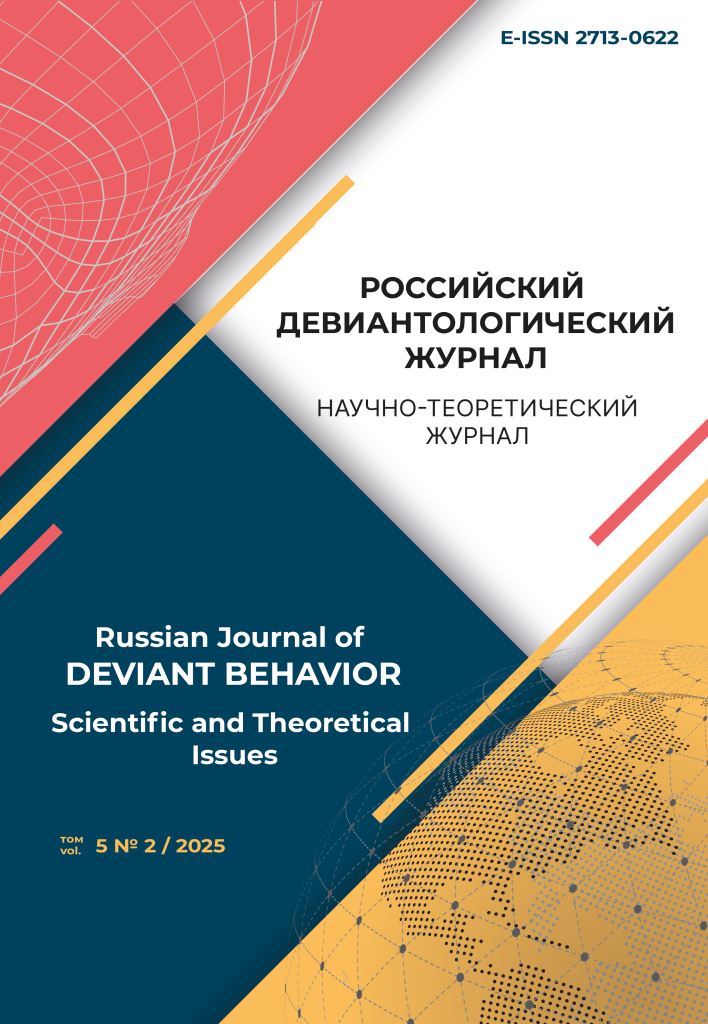Russian Federation
UDC 159.9
UDC 316.624
The relevance of the research is determined by the need to develop the methodology of criminal psychology, to increase its sensitivity to the individual characteristics shaping criminal personality and, as a consequence, to improve the quality of diagnostic and correctional work with criminogenic individuals. The theory of psychoanalysis originates in the highly controversial assumption of a deep mental life remaining unconscious to its subject, but driving a person to commit a crime. With no sufficient experimental confirmation, psychoanalytical ideas are realised in psychological approaches concerning the study of offenders and criminals, thus demonstrating their heuristic potential. The purpose of the research is to determine the validity of psychoanalytic theory of personality and its methodology for improving criminal psychology. Methods. The research is based on a set of general scientific methods of working with information – analysis and synthesis are applied to psychoanalytic structure of personality and functions of its components that determine criminal and law-abiding behaviour. The method of generalisation is used to identify psychoanalytical ideas and concepts of criminal personality, that are of interest for developing criminal psychology and that require experimental verification. Results. Psychoanalytical ideas on the structure of criminal personality are analysed. Drawing upon foreign studies, the author examines the researchers’ ideas on unconscious instincts driving a person to commit a crime, as well as intrapersonal mechanisms restraining and regulating their exteriorisation. Criticism of neurotic, infantile and psychotic concepts of criminal personality by the followers of Z. Freud is provided. The functions and states of personality components counteracting antisocial and criminal impulses of the unconscious are revealed; the information on their empirical verification is detailed. The psychoanalytic interpretation of a person’s anxiety preceding a crime, and the guilt following its comission is described. The result of the research is a generalisation of functions and states of intrapersonal structures that regulate unlawful acts and foster lawabiding behaviour. The findings are of practical importance for the development of diagnostic methods, models of psychocorrective and psychopreventive work, involving their experimental verification.
criminal psychoanalysis, criminal personality, unconscious motives, irrational aggression, serial crimes, criminal psychology
1. Antonyan, Yu. M. (2015). Bessoznatel'noe v korystnom prestupnom povedenii. Obshchestvo i pravo, 2 (52), 120–128.
2. Antonyan, Yu. M. (2020). Kriminologiya sadizma. Obshchestvo i pravo, 2 (72), 41–48.
3. Antonyan, Yu. M. (2024). Psihicheskaya zavisimost' i prestupnoe povedenie. Obshchestvo i pravo, 1 (87), 8–15.
4. Antonyan, Yu. M. (2025). Kriminogennaya znachimost' trevozhnosti. Nauchnyj portal MVD Rossii, 1 (69), 56–62.
5. Albrecht, G. L. (2006). Sigmund freud, from some character-types met with in psychoanalytic work (1916). In G. L. Albrecht (Ed.), Encyclopedia of disability (Vol. 5, pp. v358-v359). SAGE Publications, Inc. https://doi.org/10.4135/9781412950510.n1034
6. Alexander, F. (1930). The Neurotic Character. International Journal of Psychoanalysis, 11, 292–311.
7. Alexander, F. (1961). The Scope of Psychoanalysis. New York: Basic Books.
8. Alexander, F., & Staub, H. (1956). The criminal, the judge and the public. Glencoe, Ill.: Free Press.
9. Anastasopoulos, D., Lignos, E., & Waddell, M. (Eds.). (1999). Psychoanalytic Psychotherapy of the Severely Disturbed Adolescent (1st ed.). Routledge. https://doi.org/10.4324/9780429479045
10. Aragno, A. (2014). The Roots of Evil: A Psychoanalytic Inquiry. Psychoanalytic Review, 101, 249–288.
11. Asch, S. S. (1974). Some Superego Considerations in Crime and Punishment. The Journal of Psychiatry & Law, 2 (2), 159–181. https://doi.org/10.1177/009318537400200204
12. Bailey R, Pico J. Defense Mechanisms. (Updated 2023 May 22). In StatPearls [Internet]. Treasure Island (FL): StatPearls Publishing; 2025 Jan-. Available from: https://www.ncbi.nlm.nih.gov/books/NBK559106
13. Bowlby, J. (1944). Forty-four juvenile thieves: their characters and home-life. The International Journal of Psychoanalysis, 25, 19–53.
14. Brody, Y., & Rosenfeld, B. (2002). Object Relations in Criminal Psychopaths. International Journal of Offender Therapy and Comparative Criminology, 46 (4), 400–411. https://doi.org/10.1177/0306624X02464003
15. Costello, S. J. (2018). The Pale Criminal. Routledge. https://doi.org/10.4324/9780429482649
16. De Masi, F. (2020). The perverse and the psychotic superego. International Journal of Psychoanalysis, 101, 735–739.
17. Dorfman, L. Ya., & Zlokazov, K. V. (2016). Defeat and Destructive Patterns: A Brief Review of Recent Studies. Part I. Bulletin of the South Ural State University. Ser. Psychology, 9 (1), 5–16. https://doi.org/10.14529/psy160101
18. Dukes, G. (1946). The Development of Psycho-Analytic Criminology. International Journal of Psycho¬analysis, 27, 145–151.
19. Fenichel, O. (1934). Outline of Clinical Psychoanalysis — Concluded. Psychoanalytic Quarterly, 3, 223–302.
20. Ferguson, M. (1988). The Clinical Situation and Epistemological Problems in Psychoanalysis: A Response to Grünbaum. Psychoanalysis and Contemporary Thought, 11, 535–561.
21. Fitzpatrick, J. J. (1976). Psychoanalysis and Crime: A Critical Survey of Salient Trends in the Literature. The Annals of the American Academy of Political and Social Science, 423 (1), 67–74. https://doi.org/10.1177/000271627642300107
22. Freud S. (1908). Die «kulturelle» Sexualmoral und die moderne Nervosität. Sexual-Probleme, 4 (3), 107–129. URL: https://www.psychanalyse.lu/Freud/FreudSexualmoral.pdf
23. Freud, S. (1965). New introductory lectures on psychoanalysis. New York: Norton.
24. Freud, A. (1937). The Ego and the Mechanisms of Defence. London: Hogarth Press.
25. Freud, S. (1906). Psycho-Analysis and the Establishment of the Facts in Legal Proceedings. The Standard Edition of the Complete Psychological Works of Sigmund Freud, 9, 97–114.
26. Freud, S. (1931/1971). The expert opinion in the Halsmann case, in The Future of an Illusion: Civilisation and its Discontents, Standard Edition of the Complete Works, 21 , 251–253. Hogarth/Institute of Psycho-Analysis: London.
27. Freud, S. (1947). The Question Of Lay Analysis An Introduction To Psychoanalysis. Imago Publishing Company, Limited.
28. Glover, E. (1952). Research methods in psychoanalysis. The International Journal of Psychoanalysis, 33, 403–409.
29. Goldstein, J. (1968). Psychoanalysis and Jurisprudence. The Yale Law Journal, 77(6), 1053–1077. https://doi.org/10.2307/794884.
30. Goldstein, R. L. (1983). Sigmund Freud: Forensic psychiatrist. Bulletin of the American Academy of Psychiatry & the Law, 11 (3), 273–277.
31. Hacker, F. J. (1962). The Discriminatory Function of the Ego. International Journal of Psychoanalysis, 43, 395–405.
32. Hartmann, H. (1958). Ego psychology and the problem of adaptation. New York: International University Press.
33. Hoffmann, K., & Kluttig, T. (2006). Special Section: Psychoanalytic and Group-Analytic Perspectives in Forensic Psychotherapy. Group Analysis, 39 (1), 9–23. https://doi. org/10.1177/0533316406062321
34. Hogan, R. (1970). A dimension of moral judgment. Journal of Consulting and Clinical Psychology, 35 (2), 205–212. https://doi.org/10.1037/h0030095
35. Johnson, A. M., & Szurek, S. A. (1952). The Genesis of Antisocial Acting Out in Children and Adults. The Psychoanalytic Quarterly, 21 (3), 323–343. https://doi.org/10.1080/21674086.195 2.11925884
36. Kupfersmid, J. (1995). Does the Oedipus complex exist? Psychotherapy: Theory, Research, Practice, Training, 32, 535–547. https://doi.org/10.1037/0033-3204.32.4.535
37. Lacan, J. (2001). Prémisses à tout développement possible de la criminology. Autres écrits (pp. 121–125). Paris, Le Seuil.
38. Lacan, J. (1996). A Theoretical Introduction to the Functions of Psychoanalysis in Criminology. Psychoanalysis Culture and Society, 1, 13–25.
39. Lagache, D. (1993). The Works of Daniel Lagache: Selected Papers, 1938–1964. Retrieved from: https://books.google.ru/books?id=47OOKf4UPUcC
40. Laufer, W. S., Johnson, J. A., & Hogan, R. (1981). Ego control and criminal behavior. Journal of Personality and Social Psychology, 41 (1), 179–184. https://doi.org/10.1037/0022-3514.41.1.179
41. Laws, B. (2020). Reimaging ‘the Self ’ in Criminology: Transcendence, Unconscious States and the Limits of Narrative Criminology. Theoretical Criminology, 26 (3), 475–493. https://doi.org/10.1177/1362480620919102
42. Levinson, D. J. (1952). Criminality from a sense of guilt; a case study and some research hypotheses. Journal of personality, 20 (4), 402–429. https://doi.org/10.1111/j.1467-6494.1952.tb01117.x
43. Lukas, E. (1947). Maturity and Crime. American Journal of Psychoanalysis, 7, 82–84.
44. Megargee, E. I. (1966). Undercontrolled and overcontrolled personality types in extreme antisocial aggression. Psychological Monographs: General and Applied, 80 (3), 1–29. https://doi.org/10.1037/ h0093894
45. Miller, S. J. (2003). Analytic Gains and Anxiety Tolerance: Punishment Fantasies and the Analysis of Superego Resistance Revisited. Psychoanalytic Psychology, 20 (1), 4–17.
46. Murray, J. M. (1964). Narcissism and the ego ideal. Journal of the American Psychoanalytic Association, 12, 477–511.
47. Nunberg, H. (1942). Ego Strength and Ego Weakness. American Imago, 3 (3), 25–40. http://www.jstor.org/ stable/26301136
48. Robinson, R. A., & Gadd, D. (2015). Annihilation anxiety and crime. Theoretical Criminology, 20 (2), 185–204. https://doi.org/10.1177/1362480615594872
49. Smith, D. (2006). Making sense of psychoanalysis in criminological theory and probation practice. Probation Journal, 53 (4), 361–376. https://doi.org/10.1177/0264550506069361
50. Wulach, J. S. (1983). August Aichorn’s Legacy: The Treatment of Narcissism in Criminals. International Journal of Offender Therapy and Comparative Criminology, 27 (3), 226–234. https://doi.org/10.1177/0306624X8302700305
51. Wyse, J. J., Harding, D. J., & Morenoff, J. D. (2014). Romantic Relationships and Criminal Desistance: Pathways and Processes. Sociological forum (Randolph, N. J.), 29 (2), 365–385. https://doi.org/10.1111/socf.12088
















